Nursing and Midwifery Board of Australia v Jones 2017
VerifiedAdded on 2023/06/11
|9
|2426
|476
AI Summary
This article discusses the importance of individual, collegial and organizational accountability in nursing practice through the case of Nursing and Midwifery Board of Australia v Jones 2017. It highlights the violation of ethical conduct and standard of practice by the nurse and the role of other health professionals and health organizations in preventing such misconducts.
Contribute Materials
Your contribution can guide someone’s learning journey. Share your
documents today.
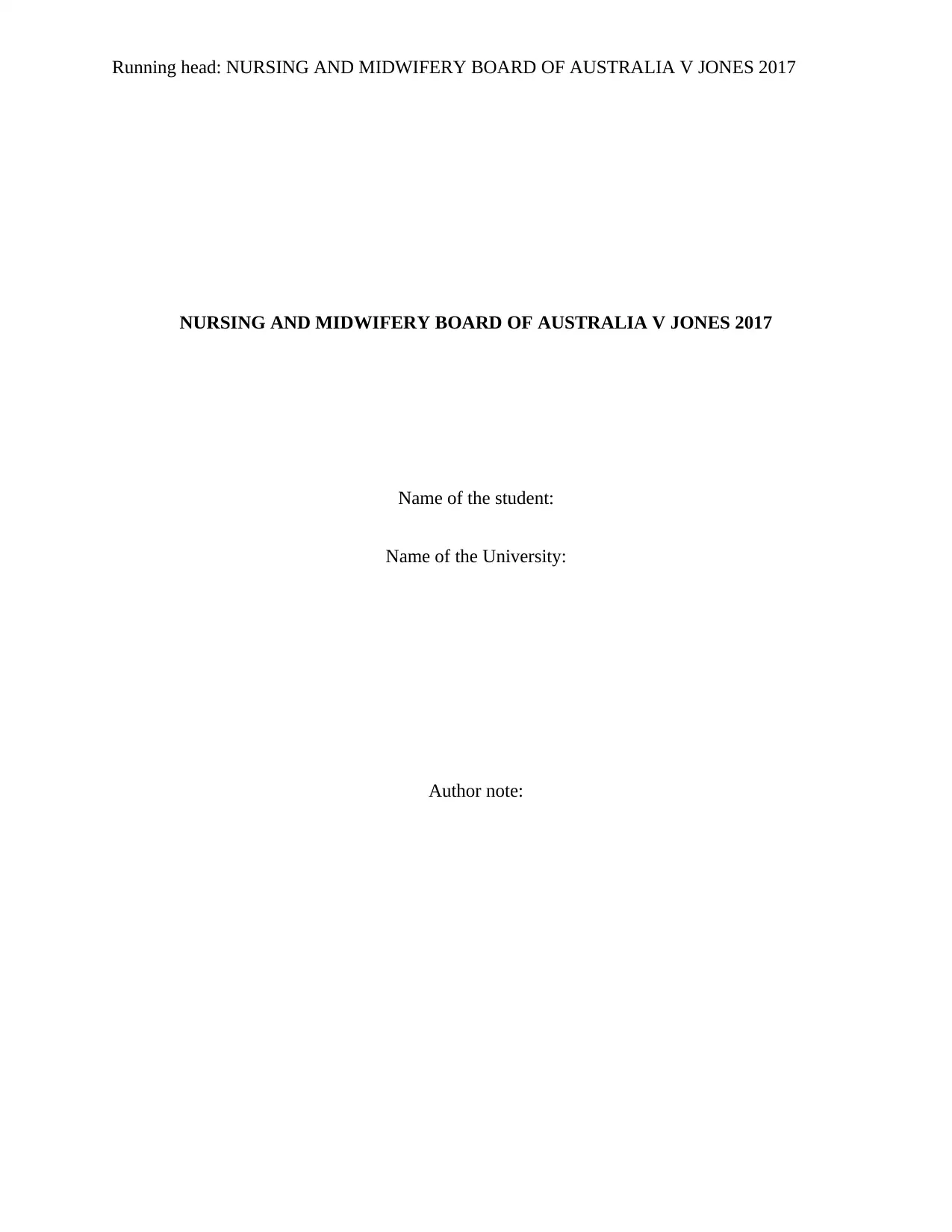
Running head: NURSING AND MIDWIFERY BOARD OF AUSTRALIA V JONES 2017
NURSING AND MIDWIFERY BOARD OF AUSTRALIA V JONES 2017
Name of the student:
Name of the University:
Author note:
NURSING AND MIDWIFERY BOARD OF AUSTRALIA V JONES 2017
Name of the student:
Name of the University:
Author note:
Secure Best Marks with AI Grader
Need help grading? Try our AI Grader for instant feedback on your assignments.

1NURSING AND MIDWIFERY BOARD OF AUSTRALIA V JONES 2017
Individual Accountability:
Individual accountability in clinical practice means being accountable for the purpose and
decisions made during the course of professional practice (Nunes, Rego & Nunes, 2013). The
midwives and nurses are answerable to the responsible authority both by professionally and
legally for the consequence of the decisions that they have made in their practice because from
this they could understand their mistakes and introduce effective strategies to maintain the rules
and regulation regarding the standard of nursing practice provided by the NMBA in order to
improve their skills (Masters, 2015). In the case of nursing and midwifery board of Australia v
Jones is related to the complaint against the nurse Jones who has failed to provide effective
service to the patient and fulfil the responsibilities of a nurse. According to the case the nurse
failed to comply with proper medication and provided dishonest answer during the inquiry of
Registered nurse. The nurse counterfeited the initials of another nurse on drug chart regarding
the drug administration to the patient and misled that nurse for the initials. Other complaint
includes dishonest respond to the nursing agency, made false respond to the AHPRA
investigator, theft cash from a patient and application for enrolled nurse to NMBA with false
information. Such actions of the nurse have violated the code of conduct and standard provided
by the NMBA for the registered nurses (Griffith, 2015). It is important for the registered nurse to
use ethical framework for making a decision during their professional practice (Faden et al.,
2013). Timely documentation, assessment of risk and medication, planning, action and
evaluation of their activity is important in order to comply with their responsibility and provide
effective service considering the safety of the patient (Dekker, 2016). The action regarding the
failure to provide proper medication to the patient has lead to the utmost violation of such
Individual Accountability:
Individual accountability in clinical practice means being accountable for the purpose and
decisions made during the course of professional practice (Nunes, Rego & Nunes, 2013). The
midwives and nurses are answerable to the responsible authority both by professionally and
legally for the consequence of the decisions that they have made in their practice because from
this they could understand their mistakes and introduce effective strategies to maintain the rules
and regulation regarding the standard of nursing practice provided by the NMBA in order to
improve their skills (Masters, 2015). In the case of nursing and midwifery board of Australia v
Jones is related to the complaint against the nurse Jones who has failed to provide effective
service to the patient and fulfil the responsibilities of a nurse. According to the case the nurse
failed to comply with proper medication and provided dishonest answer during the inquiry of
Registered nurse. The nurse counterfeited the initials of another nurse on drug chart regarding
the drug administration to the patient and misled that nurse for the initials. Other complaint
includes dishonest respond to the nursing agency, made false respond to the AHPRA
investigator, theft cash from a patient and application for enrolled nurse to NMBA with false
information. Such actions of the nurse have violated the code of conduct and standard provided
by the NMBA for the registered nurses (Griffith, 2015). It is important for the registered nurse to
use ethical framework for making a decision during their professional practice (Faden et al.,
2013). Timely documentation, assessment of risk and medication, planning, action and
evaluation of their activity is important in order to comply with their responsibility and provide
effective service considering the safety of the patient (Dekker, 2016). The action regarding the
failure to provide proper medication to the patient has lead to the utmost violation of such
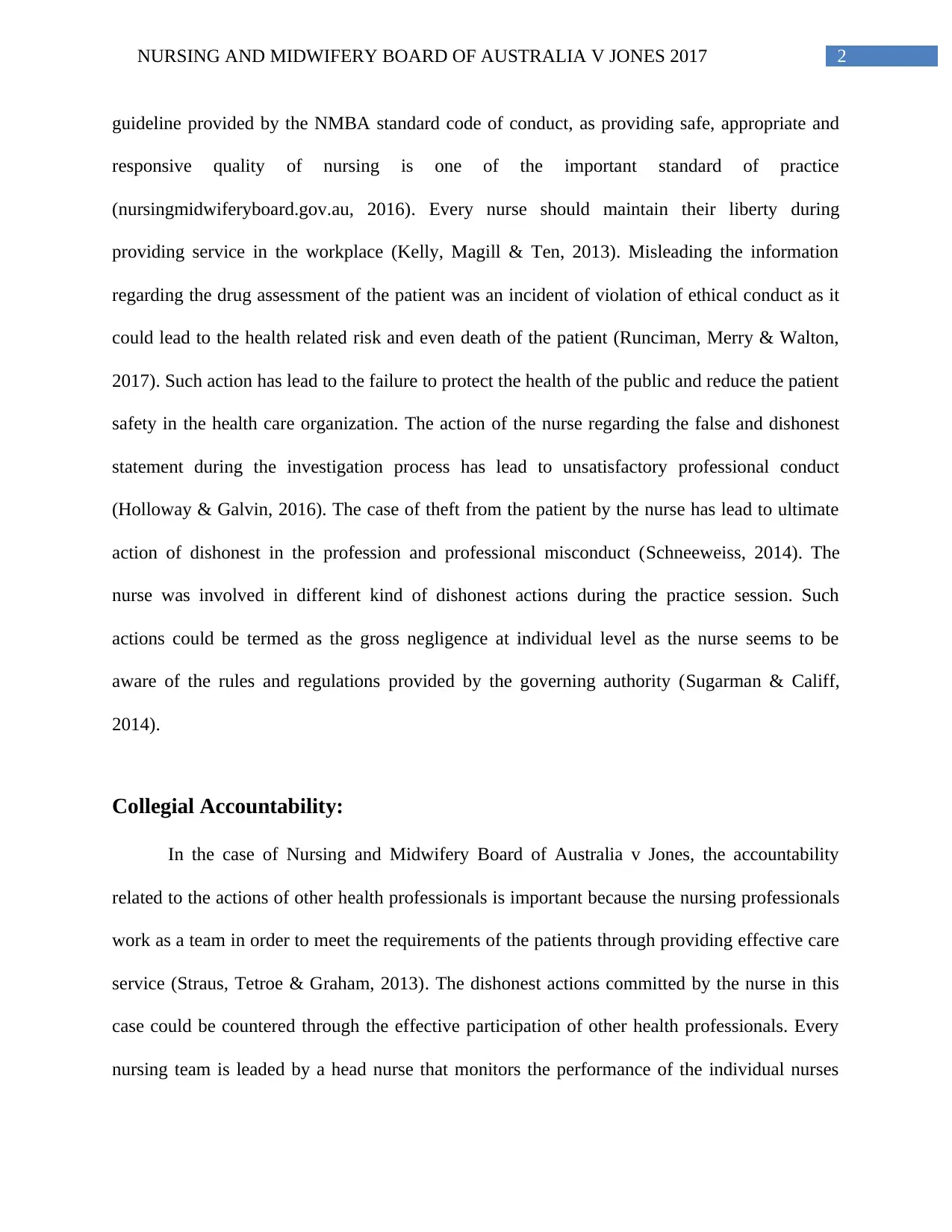
2NURSING AND MIDWIFERY BOARD OF AUSTRALIA V JONES 2017
guideline provided by the NMBA standard code of conduct, as providing safe, appropriate and
responsive quality of nursing is one of the important standard of practice
(nursingmidwiferyboard.gov.au, 2016). Every nurse should maintain their liberty during
providing service in the workplace (Kelly, Magill & Ten, 2013). Misleading the information
regarding the drug assessment of the patient was an incident of violation of ethical conduct as it
could lead to the health related risk and even death of the patient (Runciman, Merry & Walton,
2017). Such action has lead to the failure to protect the health of the public and reduce the patient
safety in the health care organization. The action of the nurse regarding the false and dishonest
statement during the investigation process has lead to unsatisfactory professional conduct
(Holloway & Galvin, 2016). The case of theft from the patient by the nurse has lead to ultimate
action of dishonest in the profession and professional misconduct (Schneeweiss, 2014). The
nurse was involved in different kind of dishonest actions during the practice session. Such
actions could be termed as the gross negligence at individual level as the nurse seems to be
aware of the rules and regulations provided by the governing authority (Sugarman & Califf,
2014).
Collegial Accountability:
In the case of Nursing and Midwifery Board of Australia v Jones, the accountability
related to the actions of other health professionals is important because the nursing professionals
work as a team in order to meet the requirements of the patients through providing effective care
service (Straus, Tetroe & Graham, 2013). The dishonest actions committed by the nurse in this
case could be countered through the effective participation of other health professionals. Every
nursing team is leaded by a head nurse that monitors the performance of the individual nurses
guideline provided by the NMBA standard code of conduct, as providing safe, appropriate and
responsive quality of nursing is one of the important standard of practice
(nursingmidwiferyboard.gov.au, 2016). Every nurse should maintain their liberty during
providing service in the workplace (Kelly, Magill & Ten, 2013). Misleading the information
regarding the drug assessment of the patient was an incident of violation of ethical conduct as it
could lead to the health related risk and even death of the patient (Runciman, Merry & Walton,
2017). Such action has lead to the failure to protect the health of the public and reduce the patient
safety in the health care organization. The action of the nurse regarding the false and dishonest
statement during the investigation process has lead to unsatisfactory professional conduct
(Holloway & Galvin, 2016). The case of theft from the patient by the nurse has lead to ultimate
action of dishonest in the profession and professional misconduct (Schneeweiss, 2014). The
nurse was involved in different kind of dishonest actions during the practice session. Such
actions could be termed as the gross negligence at individual level as the nurse seems to be
aware of the rules and regulations provided by the governing authority (Sugarman & Califf,
2014).
Collegial Accountability:
In the case of Nursing and Midwifery Board of Australia v Jones, the accountability
related to the actions of other health professionals is important because the nursing professionals
work as a team in order to meet the requirements of the patients through providing effective care
service (Straus, Tetroe & Graham, 2013). The dishonest actions committed by the nurse in this
case could be countered through the effective participation of other health professionals. Every
nursing team is leaded by a head nurse that monitors the performance of the individual nurses
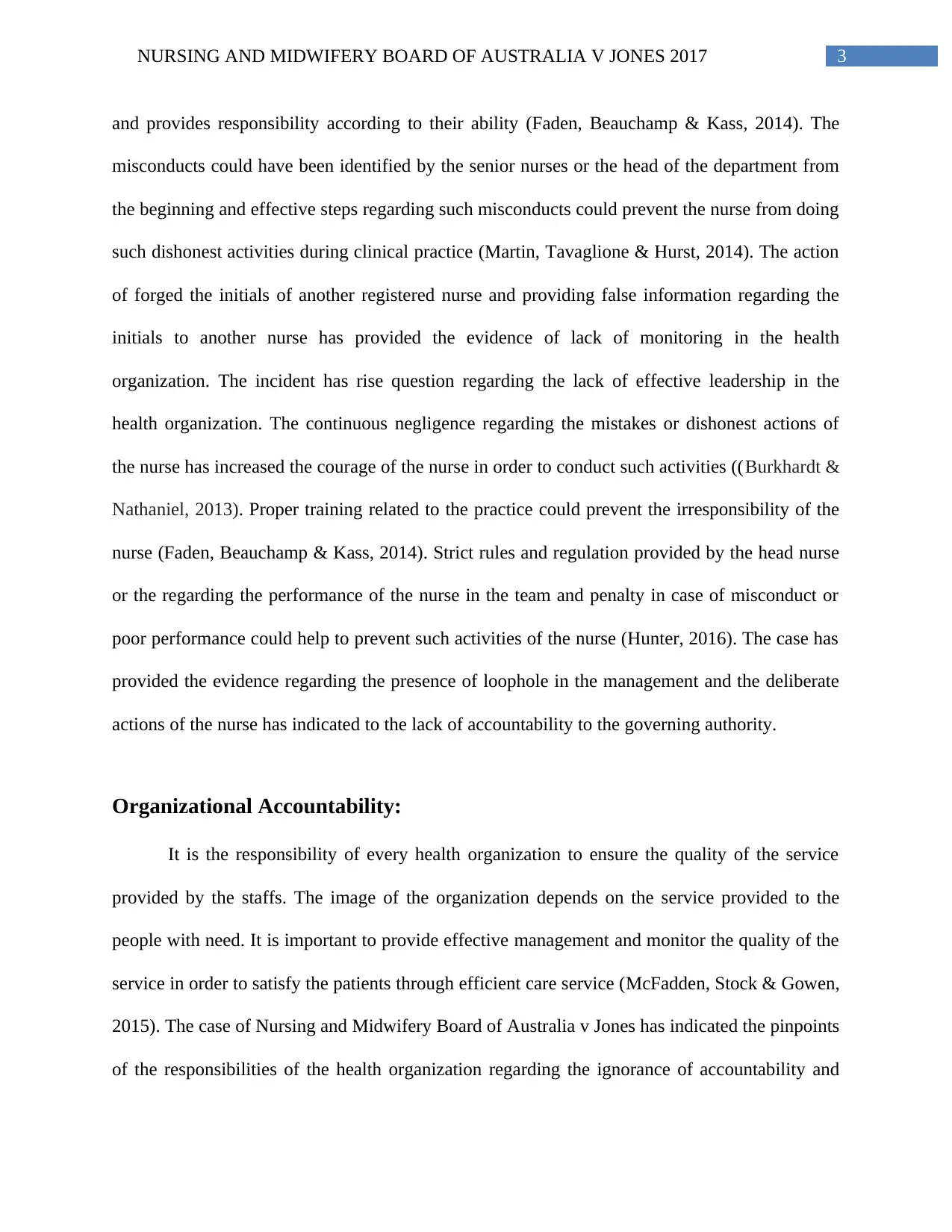
3NURSING AND MIDWIFERY BOARD OF AUSTRALIA V JONES 2017
and provides responsibility according to their ability (Faden, Beauchamp & Kass, 2014). The
misconducts could have been identified by the senior nurses or the head of the department from
the beginning and effective steps regarding such misconducts could prevent the nurse from doing
such dishonest activities during clinical practice (Martin, Tavaglione & Hurst, 2014). The action
of forged the initials of another registered nurse and providing false information regarding the
initials to another nurse has provided the evidence of lack of monitoring in the health
organization. The incident has rise question regarding the lack of effective leadership in the
health organization. The continuous negligence regarding the mistakes or dishonest actions of
the nurse has increased the courage of the nurse in order to conduct such activities ((Burkhardt &
Nathaniel, 2013). Proper training related to the practice could prevent the irresponsibility of the
nurse (Faden, Beauchamp & Kass, 2014). Strict rules and regulation provided by the head nurse
or the regarding the performance of the nurse in the team and penalty in case of misconduct or
poor performance could help to prevent such activities of the nurse (Hunter, 2016). The case has
provided the evidence regarding the presence of loophole in the management and the deliberate
actions of the nurse has indicated to the lack of accountability to the governing authority.
Organizational Accountability:
It is the responsibility of every health organization to ensure the quality of the service
provided by the staffs. The image of the organization depends on the service provided to the
people with need. It is important to provide effective management and monitor the quality of the
service in order to satisfy the patients through efficient care service (McFadden, Stock & Gowen,
2015). The case of Nursing and Midwifery Board of Australia v Jones has indicated the pinpoints
of the responsibilities of the health organization regarding the ignorance of accountability and
and provides responsibility according to their ability (Faden, Beauchamp & Kass, 2014). The
misconducts could have been identified by the senior nurses or the head of the department from
the beginning and effective steps regarding such misconducts could prevent the nurse from doing
such dishonest activities during clinical practice (Martin, Tavaglione & Hurst, 2014). The action
of forged the initials of another registered nurse and providing false information regarding the
initials to another nurse has provided the evidence of lack of monitoring in the health
organization. The incident has rise question regarding the lack of effective leadership in the
health organization. The continuous negligence regarding the mistakes or dishonest actions of
the nurse has increased the courage of the nurse in order to conduct such activities ((Burkhardt &
Nathaniel, 2013). Proper training related to the practice could prevent the irresponsibility of the
nurse (Faden, Beauchamp & Kass, 2014). Strict rules and regulation provided by the head nurse
or the regarding the performance of the nurse in the team and penalty in case of misconduct or
poor performance could help to prevent such activities of the nurse (Hunter, 2016). The case has
provided the evidence regarding the presence of loophole in the management and the deliberate
actions of the nurse has indicated to the lack of accountability to the governing authority.
Organizational Accountability:
It is the responsibility of every health organization to ensure the quality of the service
provided by the staffs. The image of the organization depends on the service provided to the
people with need. It is important to provide effective management and monitor the quality of the
service in order to satisfy the patients through efficient care service (McFadden, Stock & Gowen,
2015). The case of Nursing and Midwifery Board of Australia v Jones has indicated the pinpoints
of the responsibilities of the health organization regarding the ignorance of accountability and
Secure Best Marks with AI Grader
Need help grading? Try our AI Grader for instant feedback on your assignments.
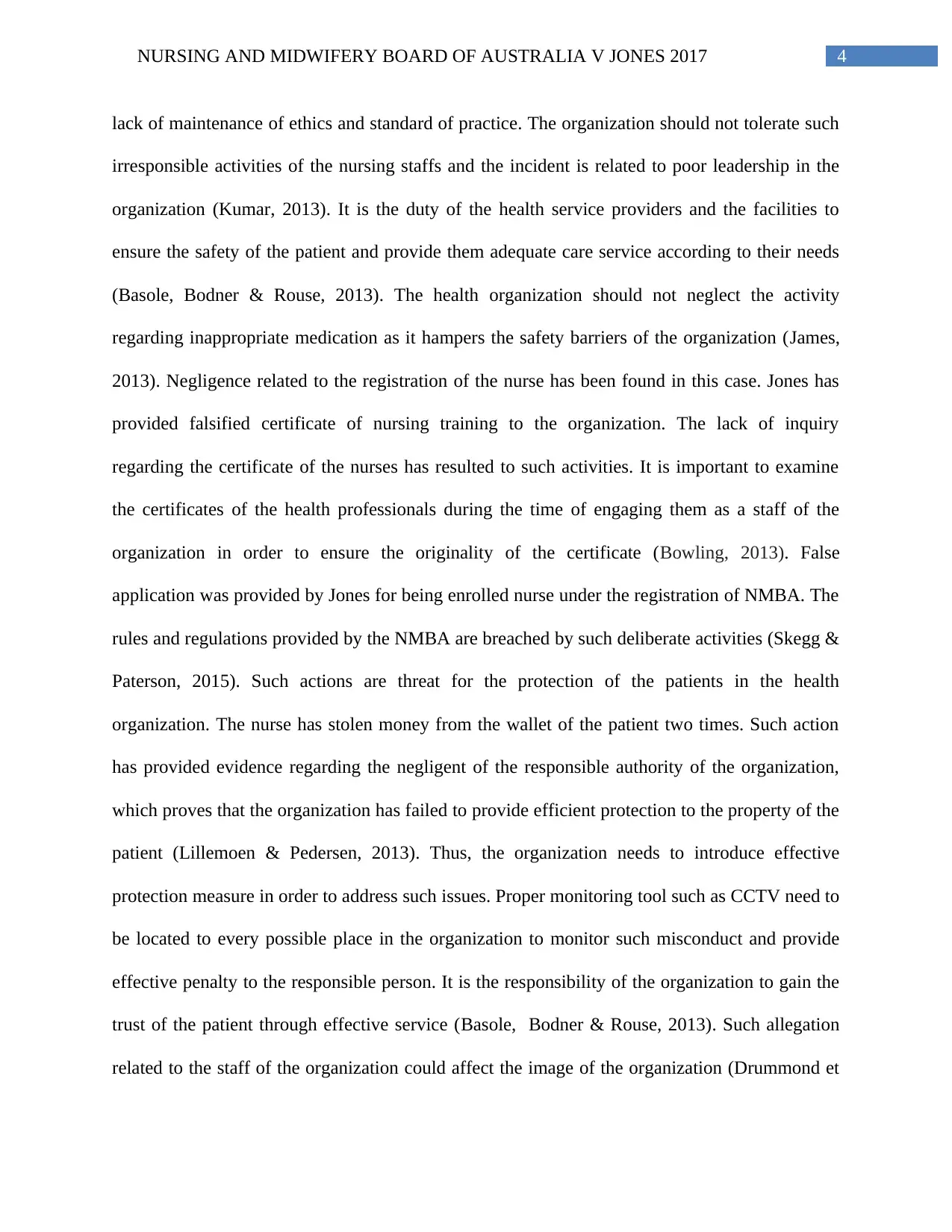
4NURSING AND MIDWIFERY BOARD OF AUSTRALIA V JONES 2017
lack of maintenance of ethics and standard of practice. The organization should not tolerate such
irresponsible activities of the nursing staffs and the incident is related to poor leadership in the
organization (Kumar, 2013). It is the duty of the health service providers and the facilities to
ensure the safety of the patient and provide them adequate care service according to their needs
(Basole, Bodner & Rouse, 2013). The health organization should not neglect the activity
regarding inappropriate medication as it hampers the safety barriers of the organization (James,
2013). Negligence related to the registration of the nurse has been found in this case. Jones has
provided falsified certificate of nursing training to the organization. The lack of inquiry
regarding the certificate of the nurses has resulted to such activities. It is important to examine
the certificates of the health professionals during the time of engaging them as a staff of the
organization in order to ensure the originality of the certificate (Bowling, 2013). False
application was provided by Jones for being enrolled nurse under the registration of NMBA. The
rules and regulations provided by the NMBA are breached by such deliberate activities (Skegg &
Paterson, 2015). Such actions are threat for the protection of the patients in the health
organization. The nurse has stolen money from the wallet of the patient two times. Such action
has provided evidence regarding the negligent of the responsible authority of the organization,
which proves that the organization has failed to provide efficient protection to the property of the
patient (Lillemoen & Pedersen, 2013). Thus, the organization needs to introduce effective
protection measure in order to address such issues. Proper monitoring tool such as CCTV need to
be located to every possible place in the organization to monitor such misconduct and provide
effective penalty to the responsible person. It is the responsibility of the organization to gain the
trust of the patient through effective service (Basole, Bodner & Rouse, 2013). Such allegation
related to the staff of the organization could affect the image of the organization (Drummond et
lack of maintenance of ethics and standard of practice. The organization should not tolerate such
irresponsible activities of the nursing staffs and the incident is related to poor leadership in the
organization (Kumar, 2013). It is the duty of the health service providers and the facilities to
ensure the safety of the patient and provide them adequate care service according to their needs
(Basole, Bodner & Rouse, 2013). The health organization should not neglect the activity
regarding inappropriate medication as it hampers the safety barriers of the organization (James,
2013). Negligence related to the registration of the nurse has been found in this case. Jones has
provided falsified certificate of nursing training to the organization. The lack of inquiry
regarding the certificate of the nurses has resulted to such activities. It is important to examine
the certificates of the health professionals during the time of engaging them as a staff of the
organization in order to ensure the originality of the certificate (Bowling, 2013). False
application was provided by Jones for being enrolled nurse under the registration of NMBA. The
rules and regulations provided by the NMBA are breached by such deliberate activities (Skegg &
Paterson, 2015). Such actions are threat for the protection of the patients in the health
organization. The nurse has stolen money from the wallet of the patient two times. Such action
has provided evidence regarding the negligent of the responsible authority of the organization,
which proves that the organization has failed to provide efficient protection to the property of the
patient (Lillemoen & Pedersen, 2013). Thus, the organization needs to introduce effective
protection measure in order to address such issues. Proper monitoring tool such as CCTV need to
be located to every possible place in the organization to monitor such misconduct and provide
effective penalty to the responsible person. It is the responsibility of the organization to gain the
trust of the patient through effective service (Basole, Bodner & Rouse, 2013). Such allegation
related to the staff of the organization could affect the image of the organization (Drummond et
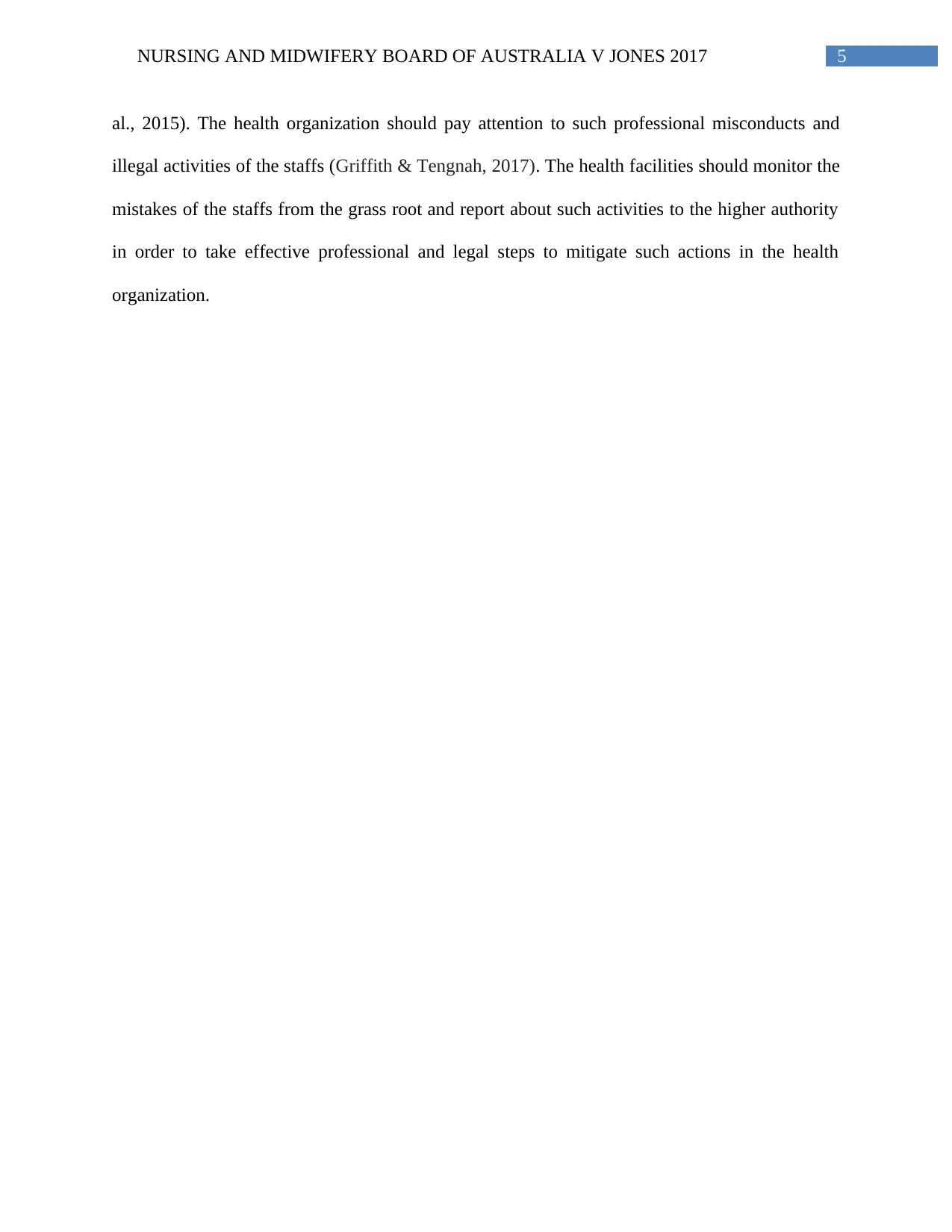
5NURSING AND MIDWIFERY BOARD OF AUSTRALIA V JONES 2017
al., 2015). The health organization should pay attention to such professional misconducts and
illegal activities of the staffs (Griffith & Tengnah, 2017). The health facilities should monitor the
mistakes of the staffs from the grass root and report about such activities to the higher authority
in order to take effective professional and legal steps to mitigate such actions in the health
organization.
al., 2015). The health organization should pay attention to such professional misconducts and
illegal activities of the staffs (Griffith & Tengnah, 2017). The health facilities should monitor the
mistakes of the staffs from the grass root and report about such activities to the higher authority
in order to take effective professional and legal steps to mitigate such actions in the health
organization.
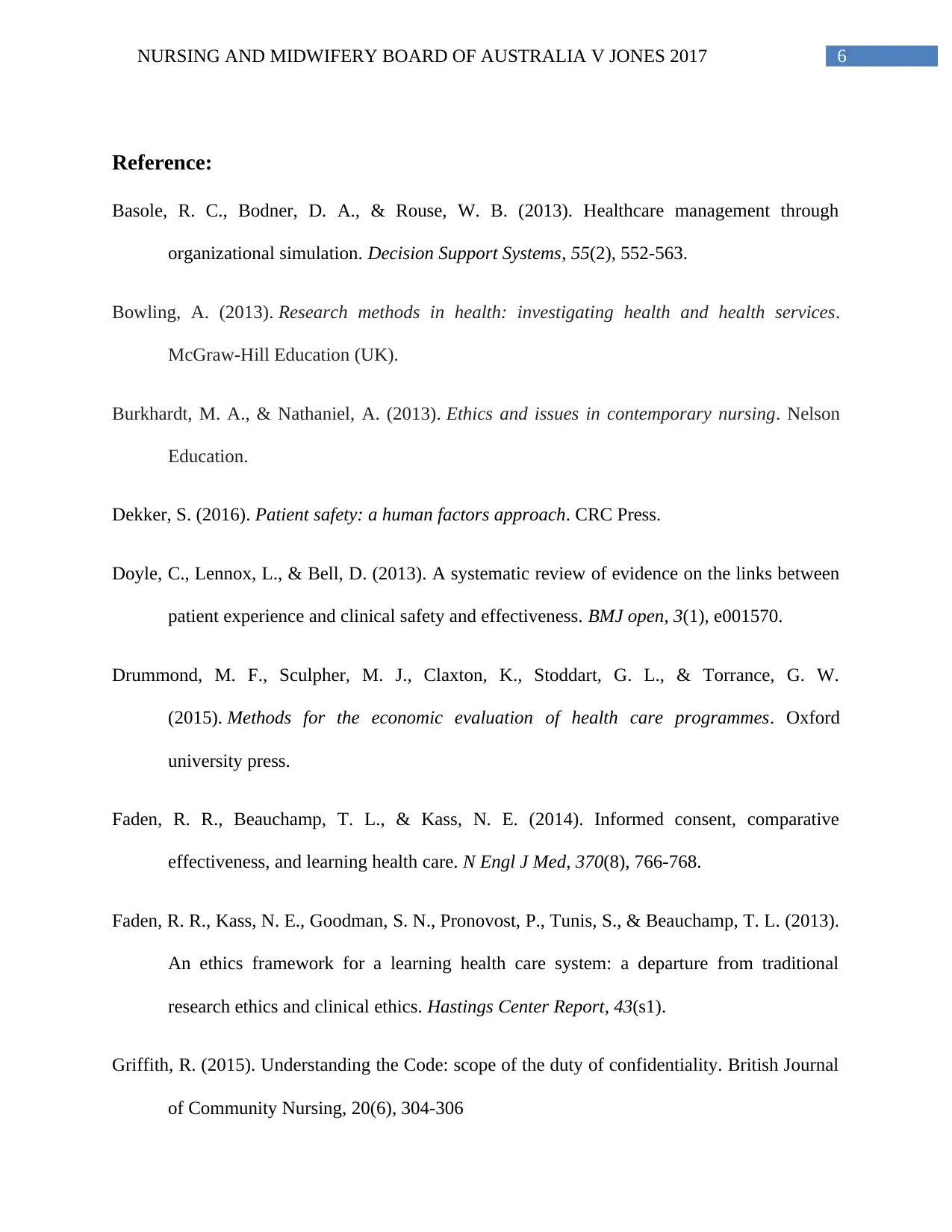
6NURSING AND MIDWIFERY BOARD OF AUSTRALIA V JONES 2017
Reference:
Basole, R. C., Bodner, D. A., & Rouse, W. B. (2013). Healthcare management through
organizational simulation. Decision Support Systems, 55(2), 552-563.
Bowling, A. (2013). Research methods in health: investigating health and health services.
McGraw-Hill Education (UK).
Burkhardt, M. A., & Nathaniel, A. (2013). Ethics and issues in contemporary nursing. Nelson
Education.
Dekker, S. (2016). Patient safety: a human factors approach. CRC Press.
Doyle, C., Lennox, L., & Bell, D. (2013). A systematic review of evidence on the links between
patient experience and clinical safety and effectiveness. BMJ open, 3(1), e001570.
Drummond, M. F., Sculpher, M. J., Claxton, K., Stoddart, G. L., & Torrance, G. W.
(2015). Methods for the economic evaluation of health care programmes. Oxford
university press.
Faden, R. R., Beauchamp, T. L., & Kass, N. E. (2014). Informed consent, comparative
effectiveness, and learning health care. N Engl J Med, 370(8), 766-768.
Faden, R. R., Kass, N. E., Goodman, S. N., Pronovost, P., Tunis, S., & Beauchamp, T. L. (2013).
An ethics framework for a learning health care system: a departure from traditional
research ethics and clinical ethics. Hastings Center Report, 43(s1).
Griffith, R. (2015). Understanding the Code: scope of the duty of confidentiality. British Journal
of Community Nursing, 20(6), 304-306
Reference:
Basole, R. C., Bodner, D. A., & Rouse, W. B. (2013). Healthcare management through
organizational simulation. Decision Support Systems, 55(2), 552-563.
Bowling, A. (2013). Research methods in health: investigating health and health services.
McGraw-Hill Education (UK).
Burkhardt, M. A., & Nathaniel, A. (2013). Ethics and issues in contemporary nursing. Nelson
Education.
Dekker, S. (2016). Patient safety: a human factors approach. CRC Press.
Doyle, C., Lennox, L., & Bell, D. (2013). A systematic review of evidence on the links between
patient experience and clinical safety and effectiveness. BMJ open, 3(1), e001570.
Drummond, M. F., Sculpher, M. J., Claxton, K., Stoddart, G. L., & Torrance, G. W.
(2015). Methods for the economic evaluation of health care programmes. Oxford
university press.
Faden, R. R., Beauchamp, T. L., & Kass, N. E. (2014). Informed consent, comparative
effectiveness, and learning health care. N Engl J Med, 370(8), 766-768.
Faden, R. R., Kass, N. E., Goodman, S. N., Pronovost, P., Tunis, S., & Beauchamp, T. L. (2013).
An ethics framework for a learning health care system: a departure from traditional
research ethics and clinical ethics. Hastings Center Report, 43(s1).
Griffith, R. (2015). Understanding the Code: scope of the duty of confidentiality. British Journal
of Community Nursing, 20(6), 304-306
Paraphrase This Document
Need a fresh take? Get an instant paraphrase of this document with our AI Paraphraser
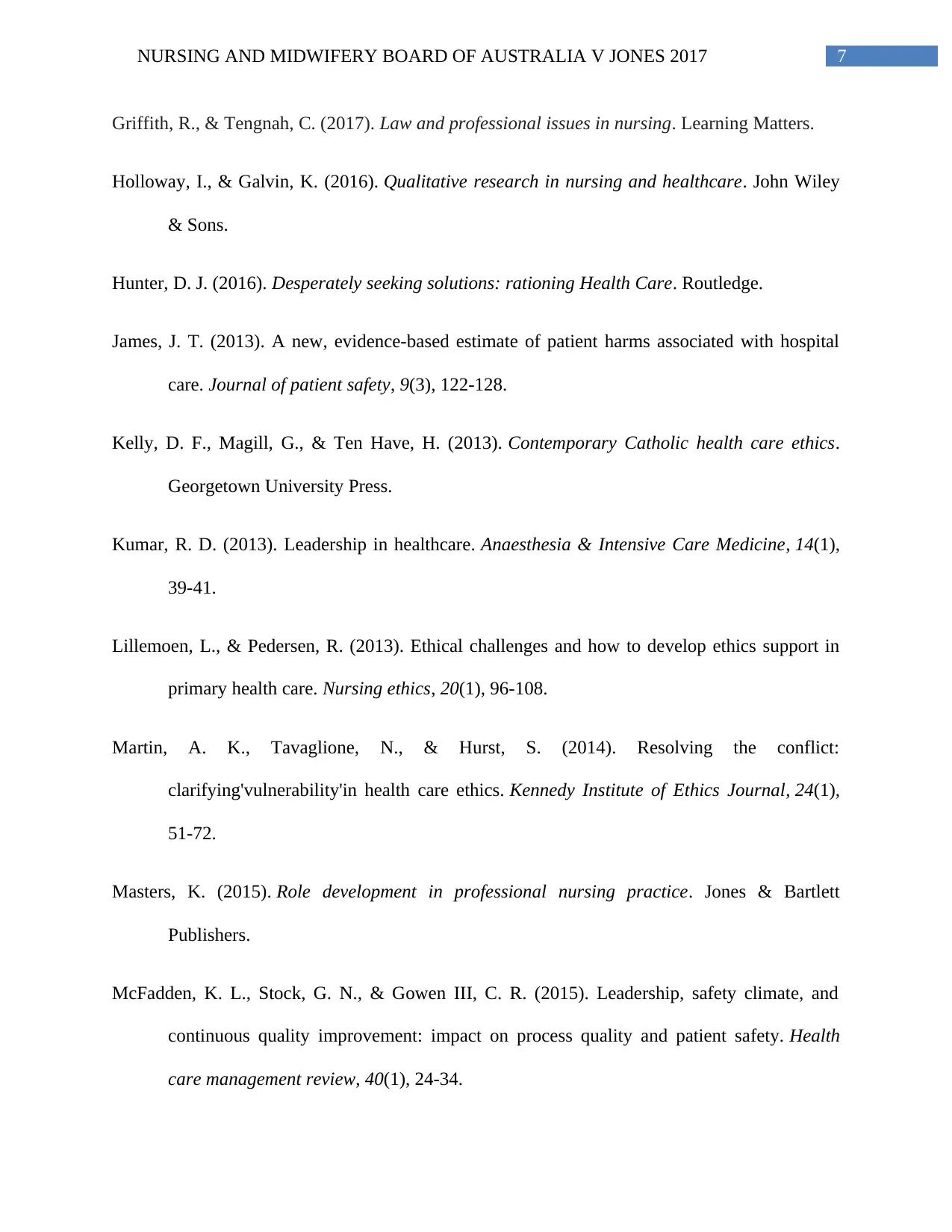
7NURSING AND MIDWIFERY BOARD OF AUSTRALIA V JONES 2017
Griffith, R., & Tengnah, C. (2017). Law and professional issues in nursing. Learning Matters.
Holloway, I., & Galvin, K. (2016). Qualitative research in nursing and healthcare. John Wiley
& Sons.
Hunter, D. J. (2016). Desperately seeking solutions: rationing Health Care. Routledge.
James, J. T. (2013). A new, evidence-based estimate of patient harms associated with hospital
care. Journal of patient safety, 9(3), 122-128.
Kelly, D. F., Magill, G., & Ten Have, H. (2013). Contemporary Catholic health care ethics.
Georgetown University Press.
Kumar, R. D. (2013). Leadership in healthcare. Anaesthesia & Intensive Care Medicine, 14(1),
39-41.
Lillemoen, L., & Pedersen, R. (2013). Ethical challenges and how to develop ethics support in
primary health care. Nursing ethics, 20(1), 96-108.
Martin, A. K., Tavaglione, N., & Hurst, S. (2014). Resolving the conflict:
clarifying'vulnerability'in health care ethics. Kennedy Institute of Ethics Journal, 24(1),
51-72.
Masters, K. (2015). Role development in professional nursing practice. Jones & Bartlett
Publishers.
McFadden, K. L., Stock, G. N., & Gowen III, C. R. (2015). Leadership, safety climate, and
continuous quality improvement: impact on process quality and patient safety. Health
care management review, 40(1), 24-34.
Griffith, R., & Tengnah, C. (2017). Law and professional issues in nursing. Learning Matters.
Holloway, I., & Galvin, K. (2016). Qualitative research in nursing and healthcare. John Wiley
& Sons.
Hunter, D. J. (2016). Desperately seeking solutions: rationing Health Care. Routledge.
James, J. T. (2013). A new, evidence-based estimate of patient harms associated with hospital
care. Journal of patient safety, 9(3), 122-128.
Kelly, D. F., Magill, G., & Ten Have, H. (2013). Contemporary Catholic health care ethics.
Georgetown University Press.
Kumar, R. D. (2013). Leadership in healthcare. Anaesthesia & Intensive Care Medicine, 14(1),
39-41.
Lillemoen, L., & Pedersen, R. (2013). Ethical challenges and how to develop ethics support in
primary health care. Nursing ethics, 20(1), 96-108.
Martin, A. K., Tavaglione, N., & Hurst, S. (2014). Resolving the conflict:
clarifying'vulnerability'in health care ethics. Kennedy Institute of Ethics Journal, 24(1),
51-72.
Masters, K. (2015). Role development in professional nursing practice. Jones & Bartlett
Publishers.
McFadden, K. L., Stock, G. N., & Gowen III, C. R. (2015). Leadership, safety climate, and
continuous quality improvement: impact on process quality and patient safety. Health
care management review, 40(1), 24-34.
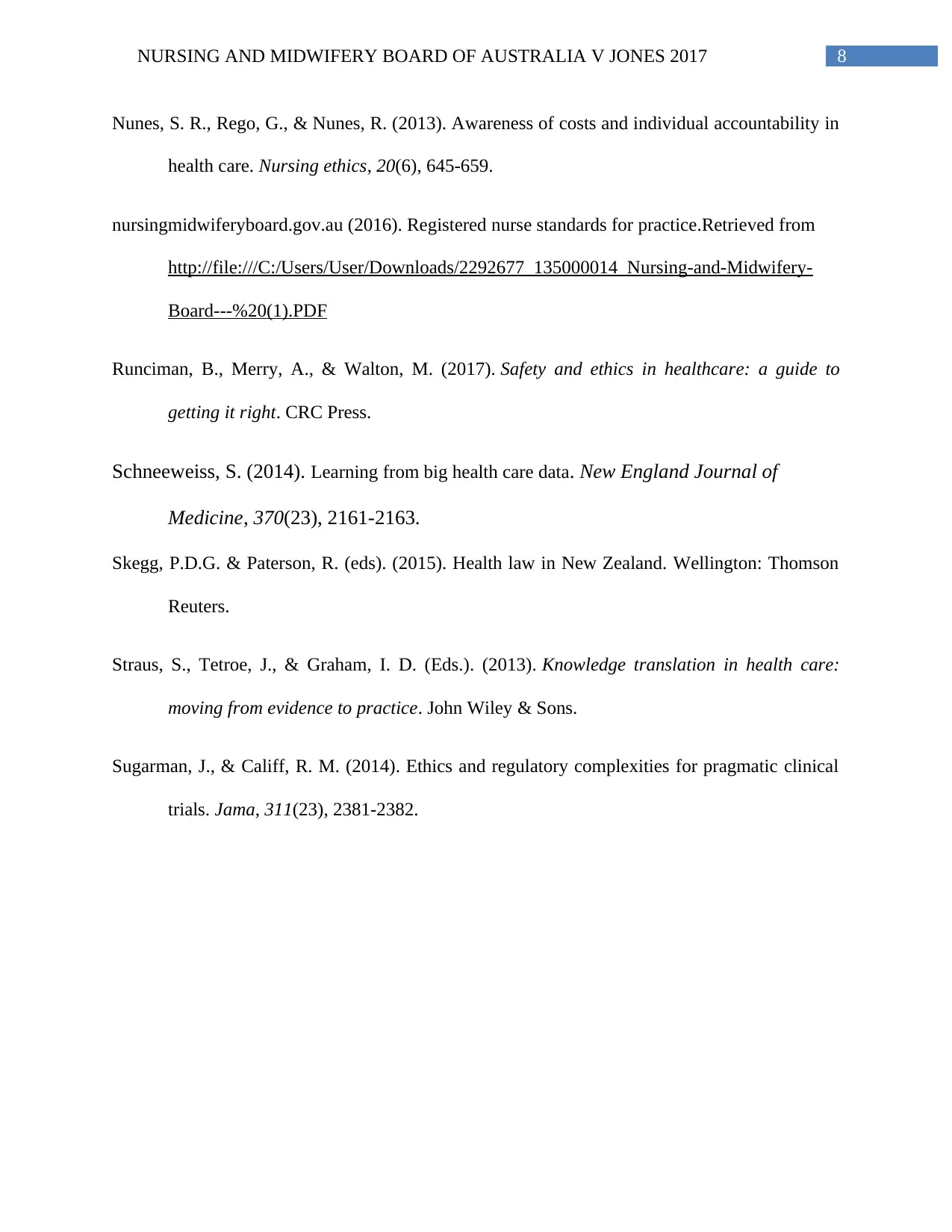
8NURSING AND MIDWIFERY BOARD OF AUSTRALIA V JONES 2017
Nunes, S. R., Rego, G., & Nunes, R. (2013). Awareness of costs and individual accountability in
health care. Nursing ethics, 20(6), 645-659.
nursingmidwiferyboard.gov.au (2016). Registered nurse standards for practice.Retrieved from
http://file:///C:/Users/User/Downloads/2292677_135000014_Nursing-and-Midwifery-
Board---%20(1).PDF
Runciman, B., Merry, A., & Walton, M. (2017). Safety and ethics in healthcare: a guide to
getting it right. CRC Press.
Schneeweiss, S. (2014). Learning from big health care data. New England Journal of
Medicine, 370(23), 2161-2163.
Skegg, P.D.G. & Paterson, R. (eds). (2015). Health law in New Zealand. Wellington: Thomson
Reuters.
Straus, S., Tetroe, J., & Graham, I. D. (Eds.). (2013). Knowledge translation in health care:
moving from evidence to practice. John Wiley & Sons.
Sugarman, J., & Califf, R. M. (2014). Ethics and regulatory complexities for pragmatic clinical
trials. Jama, 311(23), 2381-2382.
Nunes, S. R., Rego, G., & Nunes, R. (2013). Awareness of costs and individual accountability in
health care. Nursing ethics, 20(6), 645-659.
nursingmidwiferyboard.gov.au (2016). Registered nurse standards for practice.Retrieved from
http://file:///C:/Users/User/Downloads/2292677_135000014_Nursing-and-Midwifery-
Board---%20(1).PDF
Runciman, B., Merry, A., & Walton, M. (2017). Safety and ethics in healthcare: a guide to
getting it right. CRC Press.
Schneeweiss, S. (2014). Learning from big health care data. New England Journal of
Medicine, 370(23), 2161-2163.
Skegg, P.D.G. & Paterson, R. (eds). (2015). Health law in New Zealand. Wellington: Thomson
Reuters.
Straus, S., Tetroe, J., & Graham, I. D. (Eds.). (2013). Knowledge translation in health care:
moving from evidence to practice. John Wiley & Sons.
Sugarman, J., & Califf, R. M. (2014). Ethics and regulatory complexities for pragmatic clinical
trials. Jama, 311(23), 2381-2382.
1 out of 9
Related Documents
Your All-in-One AI-Powered Toolkit for Academic Success.
+13062052269
info@desklib.com
Available 24*7 on WhatsApp / Email
![[object Object]](/_next/static/media/star-bottom.7253800d.svg)
Unlock your academic potential
© 2024 | Zucol Services PVT LTD | All rights reserved.





